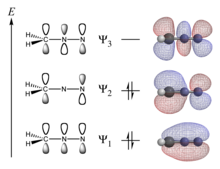سیستم مزدوج



در شیمی، سیستم مزدوج یا کونژوگه سیستمی از اوربیتالهای p متصل به هم با الکترونهای غیرمستقر در یک مولکول است که در مجموع انرژی کلی مولکول را کاهش داده و پایداری را افزایش میدهد. به طور معمول به شکل پیوندهای متناوب منفرد و چندگانه نشان داده میشود. جفتهای غیرپیوندی، رادیکالها یا یونهای کربنیوم ممکن است بخشی از سیستم باشند که میتواند حلقوی، غیر حلقوی، خطی یا ترکیبی از آنها باشند. اصطلاح مزدوج در سال ۱۸۹۹ توسط شیمیدان آلمانی یوهانس تیله ابداع شد.[۱]
مزدوج شدن عبارت است از همپوشانی یک اوربیتال p با یک اوربیتال p دیگر در طول یک پیوند σ (در فلزات واسطه، اوربیتالهای d نیز میتوانند دخیل باشند).[۲][۳]
یک سیستم مزدوج دارای ناحیهای از اوربیتالهای p همپوشانی شدهاست که در آن موقعیتهای مجاور، که در نمودارهای ساده فاقد پیوند π هستند، به صورت پل بین دو موقعیت قرار میگیرند. آنها اجازه میدهند که الکترونهای π در تمام اوربیتالهای p همترازِ مجاور جابجا شوند.[۴] الکترونهای π به یک پیوند یا اتم منفرد تعلق ندارند، بلکه به گروهی از اتمها تعلق دارند.
بزرگترین سیستمهای مزدوج در گرافن، گرافیت، پلیمرهای رسانا و نانولولههای کربنی یافت میشوند.
همچنین ببینید[ویرایش]
منابع و یادداشتها[ویرایش]
- ↑ Thiele, Johannes (1899). "Zur Kenntnis der ungesättigten Verbindungen" [[Contribution] to our knowledge of unsaturated compounds]. Justus Liebig's Annalen der Chemie (به آلمانی). 306: 87–142. doi:10.1002/jlac.18993060107. On p. 90, Thiele coined the term "conjugated": "Ein solches System benachbarter Doppelbindungen mit ausgeglichenen inneren Partialvalenzen sei als conjugirt bezeichnet." (Such a system of adjacent double bonds with equalized inner partial valences shall be termed "conjugated".)
- ↑ IUPAC, Compendium of Chemical Terminology, 2nd ed. (the "Gold Book") (1997). Online corrected version: (2006–) "conjugated system (conjugation)".
- ↑ For the purposes of this article, we are primarily concerned with delocalized orbitals with π symmetry. This is in line with the typical usage of 'conjugated system' to refer to π (and not σ) delocalization. Canonical molecular orbitals are fully delocalized, so in a sense, all electrons involved in bonding, including ones making up the σ bonds and lone pairs, are delocalized throughout the molecule. However, while treating π electrons as delocalized yields many useful insights into chemical reactivity, treatment of σ and nonbonding electrons in the same way is generally less profitable, except in cases of multicenter σ bonding as found in cluster compounds of Li and B. Moreover, the added complexity tends to impede chemical intuition. Hence, for most organic molecules, chemists commonly use a localized orbital model to describe the σ bonds and lone pairs, while superimposing delocalized molecular orbitals to describe the π bonding. This view has the added advantage that there is a clear correspondence between the Lewis structure of a molecule and the orbitals used to describe its bonding.
- ↑ March, Jerry (1985). Advanced Organic Chemistry reactions, mechanisms and structure (3rd ed.). New York: John Wiley & Sons, Inc. ISBN 0-471-85472-7.
